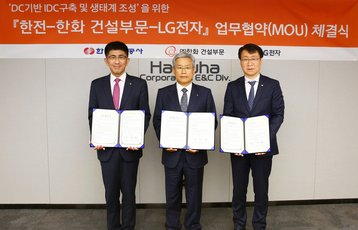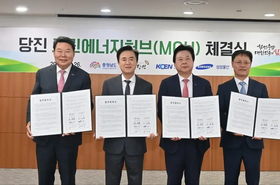LG Electronics, Korea Electric Power Corporation (KEPCO), and Hanwha Construction Division are partnering to develop a direct current-powered data center.
Last week, the three South Korean firms signed a memorandum of understanding (MoU) to establish a “DC-based data center and ecosystem.”
The three companies will build a 'power-saving data center' that supplies 1MW of the total 10MW of data center servers and cooling facilities with direct current. This is to develop a solution to reduce power consumption and heat generation in data centers by utilizing renewable energy as demand for AI data centers increases, and to commercialize their efforts.
Details weren’t shared, but the three companies said they plan to promote a pilot project for a 'power-saving data center' that will apply some DC distribution to data centers to be built by Hanwha in the future.
Kim Seung-mo, CEO of Hanwha Construction Division, said: "Hanwha will join forces with Korea Electric Power Corporation and LG Electronics to proactively promote the creation of a DC ecosystem in data center businesses and other areas."
Most power plants generate and supply alternating current (AC) electricity. However, most renewable energy sources, such as solar and wind, produce direct current (DC) electricity, which is converted to AC before being converted back to DC again later in the process.
LG Electronics plans to develop and supply a “super-large” DC-powered chiller – which it claims will be a first in Korea – to reduce the 10 percent energy loss that occurs during the conversion process.
KEPCO will be in charge of providing a stable DC power supply and technology verification based on low-voltage direct current (LVDC) transmission technology. Hanwha will design and construct the DC-type data center, introducing DC distribution networks to buildings and verifying them, and deriving commercialization models.
Chips inside servers actually generally run on DC power, but data centers receive and distribute the power in AC. This leads to a merry-go-round of AC/DC swap-overs. After receiving higher-voltage AC, the power is stepped down inside a data center to a lower voltage and safely routed to the server rooms. Much of that power is sent to the uninterruptible power supply (UPS) system, where the AC power is converted to DC power to maintain the batteries, and then converted back to AC and routed to the racks and the IT equipment. Inside each individual switch and server, the PSU or rectifier converts it again back to the DC that the electronics want.
While today’s data centers are mostly powered by AC power, many legacy central offices and other telecom-focused facilities were generally built to run on DC power. This fell out of favor around the turn of the millennium, with most new facilities built to distribute AC power.
Each conversion results in a slight loss of energy, leading to inefficiencies. As a result, some hyperscalers are exploring DC distribution as a way to remove those inefficiencies and reduce energy loss. Solar and wind farms, and many fuel cells, also push out DC power, so colocated or behind-the-meter type deployments could benefit from fewer conversions.







